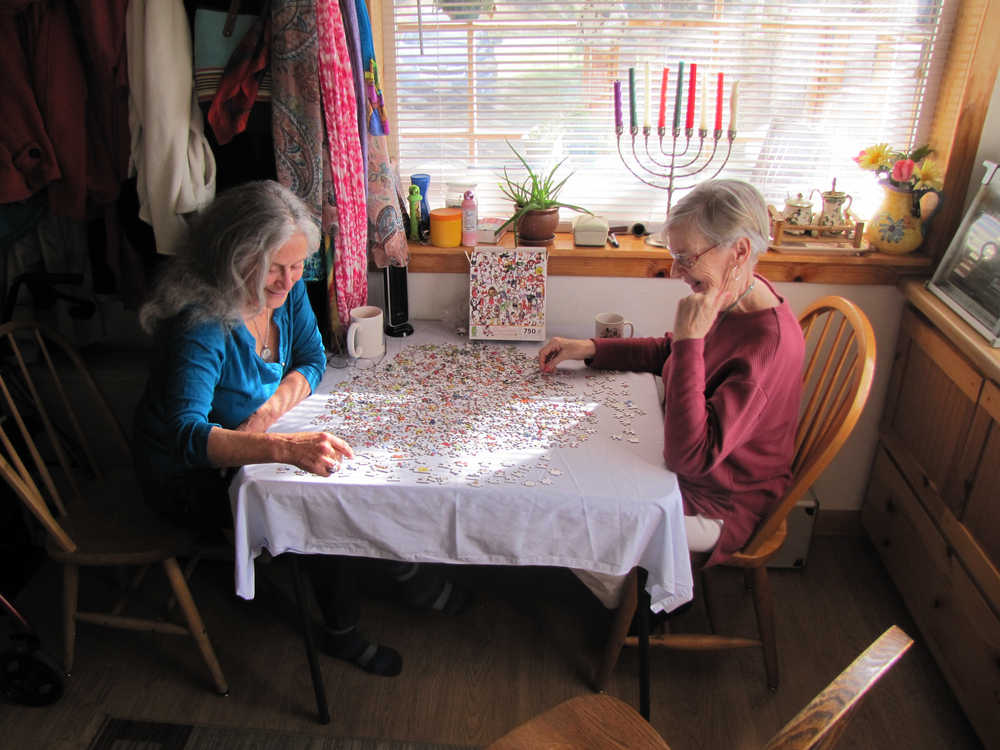Evelyn Carpenter sits at a small table surveying a scattering of unassembled puzzle pieces. She is backlit by soft sunlight radiating through a window of her cozy Anchor Point home just off North Fork Road. Her delicate 80-year-old hands shake slightly, a symptom of the Parkinson’s disease that has rendered her life increasingly difficult over the past few years.
Across the table sits her good friend Linda Feiler, who lives on the Old Sterling a few miles away. She visits Carpenter several times a week, helping her and her husband, Tom, who faces medical issues of his own, manage a few chores of their quiet rural lives. These days Carpenter finds walking difficult, bending a risk.
Feiler has been a direct-care volunteer for Hospice of Homer for several years; Carpenter is her client. When first diagnosed, Carpenter needed only a cane, a walker and such, which Hospice supplied free of charge. When Tom’s condition prevented caring for Evelyn and doing chores alone, Hospice arranged for volunteer visits. Since spring, that’s been Feiler, who not only comes to chat, but assists with cooking and and assorted other tasks. “We hit it right off,” Carpenter said.
Feiler said she loves staying for hours, though occasionally she only has time to whip up a quick meal before leaving, prompting the Carpenters to start asking, “What kind of cook cooks dinner and runs?” Evelyn tosses her head back and laughs.
Feiler takes Carpenter on errands to Homer. When she’s in Soldotna at Fred Meyer, she’ll phone so the two can “walk through the sections” together, as it were. It’s a growing friendship, something not uncommon between clients, their families and volunteers.
Darlene Hilderbrand, director of Hospice of Homer since 2002, said the non-profit agency currently has about 50 active direct-care volunteers, but additions are always welcome. Annual in-depth, cost-free training sessions — 33 hours delivered over a few weeks — are held at the hospice office on Pioneer Avenue, this year beginning Oct. 1 and running through Oct. 25. All direct-care volunteers are vetted. A test for tuberculosis, fingerprinting and a background check are required.
Hospice staff members provide most of the training, supplemented by guest speakers from Homer’s social and medical services. Trainees learn the objectives and purpose of hospice and study aspects of pain management (including spiritual pain), body mechanics, the effects of Alzheimer’s disease, and elder abuse issues, Hilderbrand said. They also learn about bereavement, funeral services, and about the other aid services available. This writer has been through the training. It is lengthy, detailed, emotional and rewarding. Volunteers take “a personal journey,” Hilderbrand said, exploring their own thoughts about giving, sharing, death and grief.
Spaces are filled for this year’s training, but there is a waiting list. If people are interested in learning how else they might help, call the hospice office.
“Contact us when you’re inspired,” Hilderbrand said. “We’ll get hold of you.”
Comforting people as they express and live with grief is one of hospice’s core services. In April of this year, Homer resident Tricia Caron lost her husband Mike Orth after his long battle with cancer. Soon after, she started attending a grief group hosted by hospice.
“It’s been really helpful. I’m almost to the point where I think maybe I could help someone else,” she said.
Even as Orth’s long illness approached inevitability, Caron said she found herself in a kind of denial.
“I knew Mike was in pain, but he was still walking and getting around.” Surely they could get along without hospice care, graced as they were with a wide circle of friends. But as care became a 24-hour-a-day affair, Caron called hospice, which provided them with medical equipment and arranged for a volunteer visitor. Caron found the experience reassuring.
“They know what you need before you know what you need,” she said. “They’re very thoughtful.”
Patty Jay, of Homer, became their volunteer visitor, seeing to some of Orth’s needs and giving Caron respite and time to herself. When the Jay traveled to Arizona, hospice sent another volunteer, Chris Perry. The two men, both fishermen, had much in common.
“They related to each other,” Caron said. He even helped resolve insurance difficulties.
“Chris appeared like an angel. He figured things out,” she said.
Roughly three out of four hospice volunteers have experienced personal grief in their lives, but that is not a necessary prerequisite for volunteering, Hilderbrand said. What it takes is “mindfulness — clearing out our own agendas and going in with an open heart and no expectations. It’s about being present with what is,” she said.
There are no “right answers” when it comes to aiding the dying and their families, she said. “You are not there to ‘fix it.’ It’s beyond a medical experience.”
Aiding clients does not always require visits. Hospice has a “phone a friend” program. As it says in the mission statement, the Volunteer Visitor & Phone a Friend Program is there to provide “comfort, dignity, and choice through care, support, and education to the frail and isolated and to those facing end-of-life issues.”
There are other options for volunteers beyond direct-care services, Hilderbrand said. Fund-raising is always in need of people willing to do a bit of legwork. Hospice’s extensive supply of medical equipment needs cleaning, maintenance and from time to time transportation to and from clients’ homes. Even office cleaning is much appreciated, she said.
Hal Spence, a former Homer News reporter, is a member of the Hospice of Homer Board of Directors.


